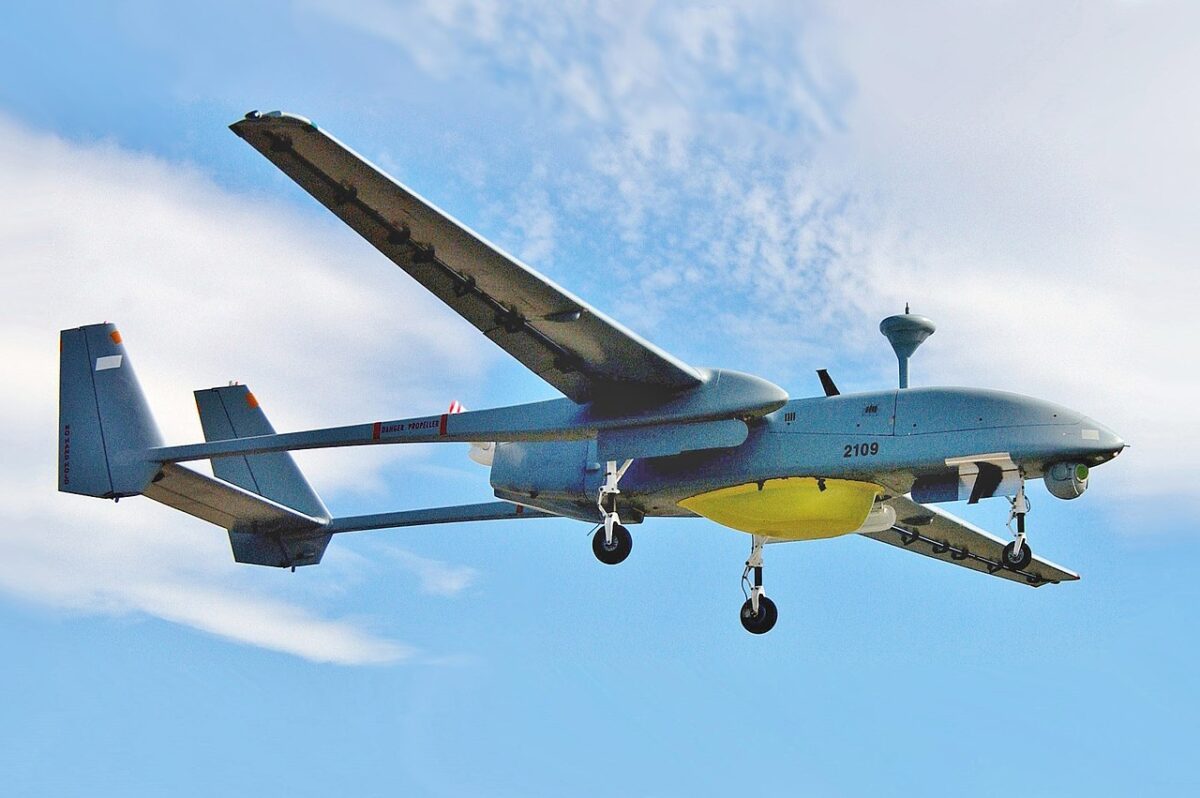Heron TP Drone, Explained By Middle East Defense Expert Maya Carlin: For nearly 30 years, a law forbade Israel’s Defense Forces from publicizing the existence of its lethal unmanned aerial vehicle (UAVs) stockpile. In July, a major shift in policy finally allowed Israeli drone manufacturers to reveal the true extent of their weapons’ capabilities.
Drone Evolution in Israeli Defenses
Although the use of armed drones is becoming more mainstream today, especially amidst Russia’s ongoing invasion of Ukraine, these weapons were not really recognized as conventional tools in modern warfare. The Jewish state, a true pioneer of drones, had been employing armed UAVs in conflicts for decades. In fact, many of the IDF’s military successes can be linked in some way to these sophisticated weapons. Israel possesses four main attack drones in its arsenal, which all display specialized attributes. Perhaps the IDF’s most specialized variant is its Eitan “Heron TP” drone.
For decades, Israeli drone manufacturers were prohibited from advertising their armed UAVs, preventing the potential export of these weapons to other countries. Although drone use in modern conflicts became more prominent following the 2020 Nagorno-Karabakh war between Azerbaijan and Armenia, the global interest in procuring these cutting-edge weapons has blown up due to the Ukraine invasion.
In both instances, Turkey’s TB2 armed drone specifically made headlines, leading to the weapons’ export and widescale recognition as a formidable piece of technology. The drone’s popularity likely impacted the Israeli government’s decision to reverse the decades-long censorship of its own indigenous armed drone programs.
Drone Manufacturers Can Expand Sales to Outside of IDF Branches
It is a great time for Israeli manufacturers to showcase the capabilities of their drones for potential exportation. According to The Times of Israel, even prior to the lifting of restrictions, “Drones made up 9 percent of Israel’s record-breaking $11.3 billion in arms exports last year, amounting to around $1 billion in sales. The global military drone market was estimated at some $10.25 billion in 2021 and is only expected to rise.” Now that the Jewish state can publicize the incredible abilities attributed its armed drones possess, these numbers will rise even higher.
Arguably the star of Israel’s armed drone stockpile is the Eitan “Heron TP.” The drone was developed by the Malat division of Israeli Aerospace Industries and initially entered service in the IDF in 2010. The Israeli Air Force’s fleet of Eitans represents its most advanced armed-UAV force in all of its avionics systems.
The Eitan Heron TP Has Distinct Advantages
As a long-endurance, medium-altitude UAV, the Eitan can function at higher altitudes above commercial air traffic and is equipped with all-weather capabilities, triple-redundant avionics, automatic takeoff and landing (ATOL) systems, among other capabilities. As described in a previous 19FortyFive article, the Eitan “can fly for approximately 40 hours straight and has a payload of 1,000 kilograms. The drone is powered by a 12,00hp Pratt and Whitney PT6A-67A turboprop engine, enabling it to fly at speeds of about 200 knots. The drone’s triple redundancy in all avionics systems makes it a powerhouse in the Israel Air Force’s arsenal.”

A Hunter Joint Tactical Unmanned Aerial Vehicle (UAV) in flight during a Combat Search and Rescue (CSAR) training exercise at Fallon Naval Air Station (NAS), Nevada (NV), during exercise DESERT RESCUE XI. The Hunter is an Israeli multi-role short-range UAV system in service with the US Army (USA). The exercise is a joint service Combat Search and Rescue (CSAR) training exercise hosted by the Naval Strike and Warfare Center, designed to simulate downed aircrews, enabling CSAR related missions to experiment with new techniques in realistic scenarios.
In 2017, the Eitan began to undergo a series of upgrades to its range and capabilities, according to Israeli news outlets. The Commander of the 210 “White Eagle” Eitan Squadron stated that the drone’s advancements would elevate it to the level of Northrop Grumman’s Global Hawk – an American-made high-altitude, long-endurance UAV. Since reports covering the drone’s upgrades were released prior to the lifting of the censorship guidelines, details on the specifics were extremely vague.
Earlier this month, a flare-up of violence between Israel and Palestinian militants based in the Gaza Strip erupted, leading to several exchanges of fire over the span of three days. Israeli military officials have asserted that its arsenal of armed and surveillance drones played outsized roles during the conflict. The IDF said that UAVS carried out more than “2,000 hours of flight time in some 100 sorties during the 66-hour battle, dubbed Operation Breaking Dawn, between August 5 and 8.”
The commander of Palmachim Brig. Gen. Omir Dor told The Times of Israel that some of the IDF’s targets during the conflict were “attacked by helicopters and fighter jets … and of course by our drones, which are also an integral part of the IDF’s offensive array.” While the Heron TP Eitan was not named directly, the advanced lethal UAV likely played a significant role in this operation.
Expert Biography: Maya Carlin is a Middle East Defense Editor with 19FortyFive. She is also an analyst with the Center for Security Policy and a former Anna Sobol Levy Fellow at IDC Herzliya in Israel. She has by-lines in many publications, including The National Interest, Jerusalem Post, and Times of Israel.

